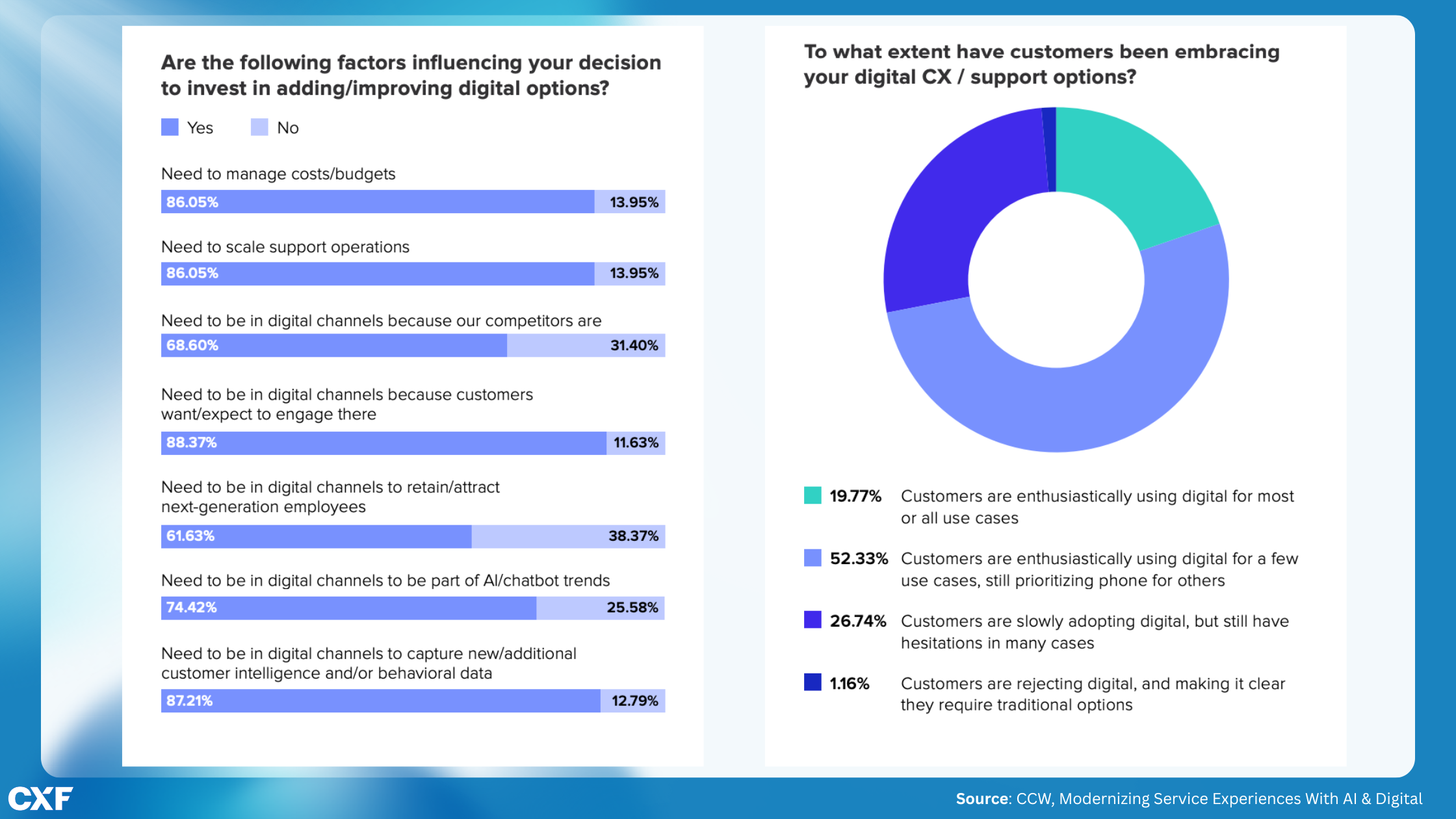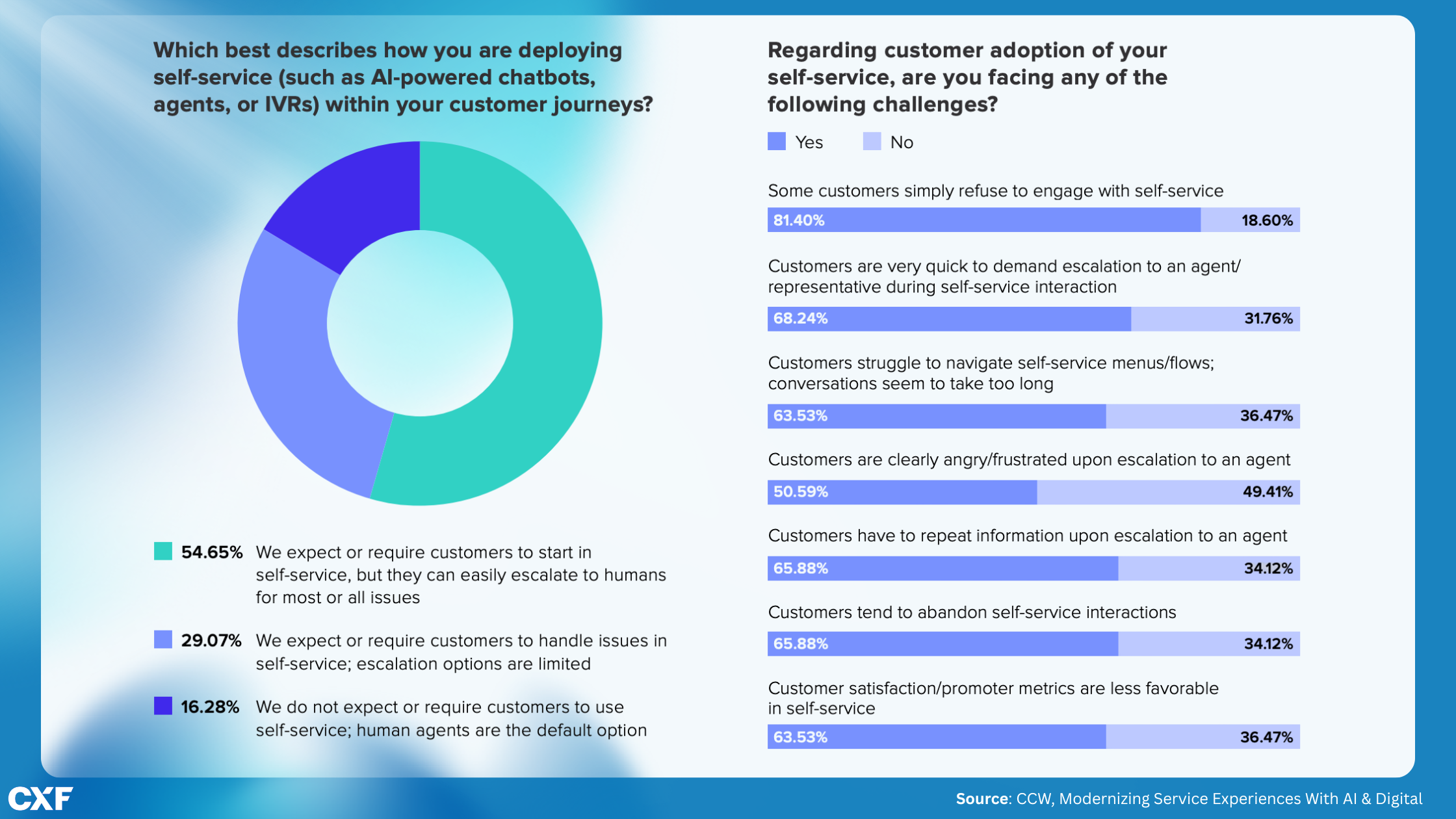October 9, 2025 • 6 min read
Stop Forcing Self-Service On Your Customers

CX Analyst & Thought Leader
October 9, 2025

While businesses overwhelmingly believe that customers prefer digital-first or self-service support, the data says otherwise. Customers still value voice support and want the chance to speak to a live agent – and many feel forced into choosing digital self-service options that don’t actually resolve their issues.
This perception gap is degrading the customer experience, eroding consumer trust, and preventing companies from realizing anticipated ROI from AI and automation investments.
(All data points cited in this article are from CCW's August 2025 Market Study, "Modernizing Service Experiences With AI & Digital").
The Digital Channel CX Perception Gap
While 88% of businesses believe customers prefer digital channels, only 20% of customers actually do. Most want the freedom to choose between digital and voice based on their support needs.

What Businesses Think of Digital Channels
88% of brands say they focus on digital communication channels because their customers prefer them to more traditional options like voice calling. Brands think customers want a digital-first experience, and believe they want to be able to resolve almost all of their support issues via digital channels. This perception has led to a dramatic rise in digital-first customer experiences, with 44% of business leaders describing their companies as such.
What Customers Want From Digital
While no one is denying that customers are using digital support channels, the truth is they don’t prefer them to more traditional channels like phone calls. Just 20% of customers prefer digital channels for most or all support issues. Over half of customers prefer using digital channels for some use cases and phone calling for others. The main reason? Lack of consumer trust in digital channels, especially those powered by AI. Customers still trust voice channels much more than digital ones. But, customers say companies are making it hard for them to connect on their preferred channel. Currently, just 22% of customers say they can choose where an interaction takes place.
When Business Priorities Overshadow CX
Even if their digital channel engagement analytics say otherwise, businesses continue to push digital. In many cases, it’s because they’ve made an enormous investment in digital channels (especially AI-powered virtual agents for self-service) but haven’t yet hit a satisfactory ROI. Additionally, over one-third of businesses say customer satisfaction scores are higher for digital channels, not traditional ones like voice. (Roughly 40% say CSAT scores in voice and digital channels are equal.) Other factors for businesses' digital-first push include keeping up with competitors, the need to scale support operations, and the desire to meet customer expectations.
Channel Flexibility Means Better Customer Insights
Businesses should give customers the choice between voice and digital channels instead of forcing a digital-first experience on them. Voice and digital channels should compliment each other, especially now that conversational AI analytics can monitor 100% of customer interactions across channels. Businesses can glean just as many “customer insights” from voice channels as they can from digital ones. Additionally, the data shows that most businesses don’t actually want digital channels to handle 100% of customer issues–which certainly makes sense from a risk management perspective.
The Self-Service Perception Gap
Given that 84% of businesses readily admit to requiring their customers to use self-service options, customers are understandably growing frustrated with "self-service only" support. And with 66% of businesses citing high self-service abandonment rates, it's clear virtual agents aren't resolving customer issues as well as brands might think.

How Businesses Approach Self-Service
Nearly 84% of businesses say they require customers to engage with a self-service tool. 55% require customers to start in a self-service portal, but provide escalation options to connect with a live agent. Shockingly, nearly 30% of businesses provide extremely limited live agent escalation options, essentially forcing their customers to solve their problems on their own. Businesses are also concerned that customers will have to repeat information they provided to a self-service tool when they’re escalated to a live agent–a well-documented CX killer. While businesses love the cost and time savings of self-service, 66% of the admit to having a high customer self-service abandonment rate.
What Customers Think of Self-Service
Customers overwhelmingly (91%) feel like businesses are forcing them to use self-service options either before or instead of speaking to a live agent. While brands understand that there will always be some customers that flat-out refuse self-service options, they don’t exactly seem eager to provide other options for the digitally hesitant. Frustrated with prior poor self-service experiences (whether with the current brand they’re interacting with or other companies) most customers almost immediately demand escalation to a live agent (68% of businesses say this is a common scenario with their customer base.)
Low Quality Self-Service Means Increased Customer Escalation
The catch-22 is that if customers aren’t using a brand’s self-service tools, they’ll never get the interaction/customer data they need to improve. And if customers instinctually escalate all their interactions to a live agent–even minor ones that a chatbot could easily resolve? They’ll face extended wait times and longer time-to-resolution. Agents will feel burned out, customer service quality will decline, and businesses won’t reap the benefits of their automation and self-service investments. The harsh reality is that a lot of self-service options aren’t as good as companies think they are. Customers can’t figure out how to navigate the self-service menus, and feel the interaction takes too long. While 83% of businesses say customers should get the same outcome from a virtual AI agent and a live representative, they need to address the quality gap first.
Give Customers A Reason To Choose Self-Service
Brands don’t deny that they essentially require customers to use self-service options, but may not be aware just how much of a negative impact this has on the customer experience. Customers don’t mind using self-service options for basic, or even more complex, support requests–but the problem is that many of them find existing self-service tools unsatisfactory.
Blinded by the push for rapid and full-scale AI adoption, some businesses may genuinely believe that virtual agents are intrinsically better than human ones. Businesses need to focus on optimizing their current self-service solutions just as much as they need to focus on agent training and coaching (including AI-powered agent assist and performance scoring.)
Closing the Digital Self-Service Perception Gap
Forcing customers into digital-first or self-service interactions doesn't improve loyalty and satisfaction: it destroys it. Businesses must balance efficiency with options while ensuring that voice and digital channels complement one another. By optimizing the quality of every channel and customer interaction instead of pushing one over the other, companies can close the perception gap, winning back customer satisfaction and trust as a result.